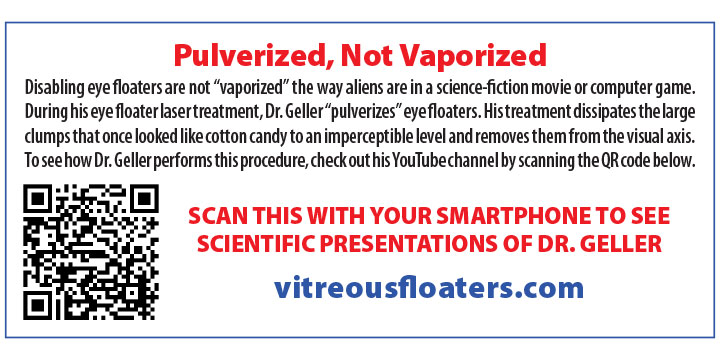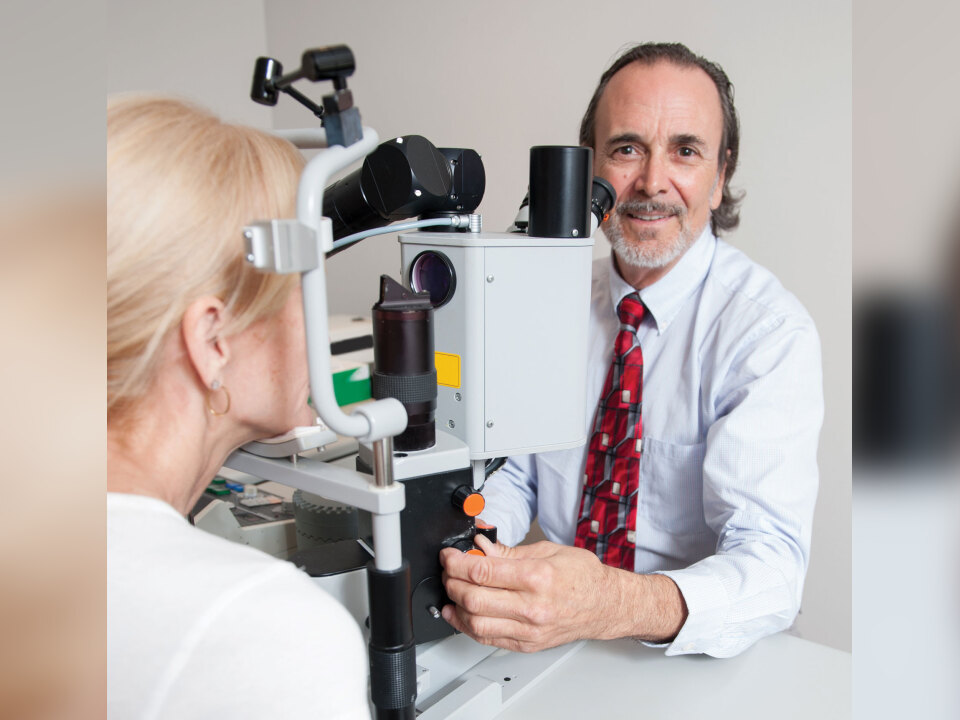Scott L. Geller, MD, is the board-certified ophthalmologist who brought an advanced laser technique for the treatment of eye floaters from Switzerland to the US and refined it to the precise level it’s at now. He specializes in a field that few eye doctors have an interest in.
“Patients often ask me, Why can’t my local doctor laser eye floaters,” Dr. Geller states. “The answer is because this is a niche area of interest, and most ophthalmologists will not take the time to really study and perfect it.
“It’s a bit like plastic surgery. Any intern can make an incision and stitch skin, but it takes years of experience to size up a patient, know exactly how to modify a technique and get the absolute best result possible.”
Dr. Geller has that experience. In Switzerland, he studied the treatment of diabetic retinal membranes under professor Franz Fankhauser, MD, a pioneer in the use of the YAG Laser in the eye. Since then, Dr. Geller has performed more than 20,000 eye floater laser procedures, possibly the world’s largest clinical series of patients.
Even the great ophthalmic institutions at the University of South Florida in Tampa and the Bascom-Palmer Eye Institute in Miami cannot make that claim. As a result, Dr. Geller has lectured and trained eye surgeons worldwide in this specialized skill and has treated patients from as far away as Siberia.
“Bringing this technique to the US sparked a great breakthrough in ophthalmology,” Dr. Geller states. “The laser has revolutionized the treatment of various eye conditions, making them easier and safer. When using the laser, there is no risk of an infection inside the eye, which can cause loss of vision.
“The patients who are referred to my practice are visually disabled by large floaters and membranes in the eye. They are not the common specks or strings the average person might see against a clear sky. These floaters are often directly in the patient’s center of vision.
“The obstruction to vision that these large floaters cause can be extreme. They can be especially hazardous to someone who is driving, someone who is performing other dangerous tasks that require precise vision, or to someone who has only one functioning eye due to an eye injury, macular degeneration or lazy eye [amblyopia] in the opposite eye.
“Our goal is to clear these obstructions, even in the most difficult of cases. In fact, we have a documented case of a patient with macular degeneration and dense eye floaters who has told us his overall quality of vision improved as a result of our eye floater laser treatment. In that case, even the patient’s retina specialist found it unbelievable.”
Understanding the Patient
Some eye specialists and institutions offer to treat patients with eye floaters by performing a vitrectomy, a surgical procedure to remove the gel called the vitreous humor that fills the inside of the eye. But it can cause complications, and sometimes patients are on blood thinners or have other issues which makes traditional “cutting” surgery inadvisable.
“Vitrectomy surgery should be the last resort for patients who cannot be helped by laser,” notes Dr. Geller.
When patients complain of eye floaters, ophthalmologists usually follow their routine of measuring the patient’s vision and checking for retinal tears or detachments. In those cases, barring anything unusual, the doctor usually says, “The retina looks fine and the floater will fade” or the patient will get used to it.
“That’s why ophthalmologists need to listen to the patient’s problem and thoroughly examine the vitreous gel, where eye floaters are formed,” Dr. Geller states. “If the ophthalmologist measures only the patient’s best vision on an eye chart, they may not correctly diagnose the problem and dismiss the patient out of hand, telling them that nothing needs to be done, which may leave the patient bewildered and frustrated.
“Live with it”- is NOT acceptable
“At our specialty clinic, we always measure the patient’s worst vision on the eye chart to see exactly how bad the vision gets with the floater obstructing it. Then we have a starting point to measure the outcome. It’s been difficult to convince other specialists to do it exactly this way.”
Dr. Geller also specializes in fixing cases that did not have a satisfactory outcome.
“Many ophthalmologists have no extensive, formal training, and they think they can just jump into this niche area of expertise,” Dr. Geller explains. “They are often too busy with other procedures like cataract surgery and glaucoma treatment to devote the time necessary to become an expert at this. As a result, the outcome of their treatment of eye floaters is often less than optimal. But I have a special interest in the treatment of eye floaters, and I invite any ophthalmologist or optometrist to visit and observe the procedure.”
So what is the procedure like?
“It’s quite easy compared to a traditional cutting operation,” Dr. Geller reports. “I start by placing a special lens on the eye, and then the laser pulverizes the opacity or creates a ‘window’ in the line of vision. Pain or even mild discomfort is unusual during this procedure, and we pride ourselves on our high level of concern for patient comfort.”
A Doctor and a Teacher
Dr. Geller has lectured all over the world – Italy, France, Germany, the Czech Republic, Turkey, China and Mexico – on the technique he developed to treat eye floaters and has treated patients referred to him from all of those countries. One of Dr. Geller’s lectures covered the onset of disabling eye floaters in patients who recently had cataract surgery.
“I gave my first presentation on this at the World Congress of Ophthalmology in Berlin, 2010,” Dr. Geller reveals. “I also presented a paper at the prestigious American Society of Cataract and Refractive Surgery that documented and described unnecessary post-cataract laser surgery for implant membrane clouding due to a missed diagnosis of eye floaters.”
Finding Dr. Geller
Patients seeking treatment from Dr. Geller are advised to call rather than email his office, but Dr. Geller confides that patients often find him in a roundabout way.

“Recently, a man in West Palm Beach went to the satellite clinic of a world-famous Miami eye institute,” the doctor reports. “They told him they couldn’t do anything for him except vitrectomy. But they also told him, There’s an ophthalmologist on the west coast of Florida who can treat your eye with a laser.
“It wasn’t a direct referral, but the patient managed to find me and was ecstatic with his results. Subsequently, I uploaded a video of his procedure that can be found on YouTube.com or at www.Vimeo.com/eyefloaters. It is one of the dozens of videos I’ve posted.”
Dr. Geller cautions that not all patients can be helped with his laser procedure, though he is pleased to report that, partially due to his meticulous patient selection process, his outcomes are positive.
“We give our patients an honest prognosis, based on our extensive experience,” the doctor explains. “Laser treatment of eye floaters is fascinating, and I look forward to doing this every day.”
Dr. Geller says that while his greatest satisfaction comes from helping patients who have been told by their ophthalmologists that nothing can be done, he welcomes the opportunity to share his technique with others in his field.
“Other ophthalmologists need only call me or ask one of my patients about their results,” he says. “I’m proud of our track record and of the patients we’ve helped.”







